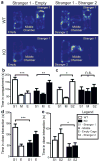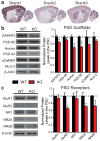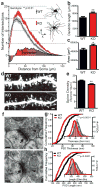Shank3 mutant mice display autistic-like behaviours and striatal dysfunction
- PMID: 21423165
- PMCID: PMC3090611
- DOI: 10.1038/nature09965
Shank3 mutant mice display autistic-like behaviours and striatal dysfunction
Abstract
Autism spectrum disorders (ASDs) comprise a range of disorders that share a core of neurobehavioural deficits characterized by widespread abnormalities in social interactions, deficits in communication as well as restricted interests and repetitive behaviours. The neurological basis and circuitry mechanisms underlying these abnormal behaviours are poorly understood. SHANK3 is a postsynaptic protein, whose disruption at the genetic level is thought to be responsible for the development of 22q13 deletion syndrome (Phelan-McDermid syndrome) and other non-syndromic ASDs. Here we show that mice with Shank3 gene deletions exhibit self-injurious repetitive grooming and deficits in social interaction. Cellular, electrophysiological and biochemical analyses uncovered defects at striatal synapses and cortico-striatal circuits in Shank3 mutant mice. Our findings demonstrate a critical role for SHANK3 in the normal development of neuronal connectivity and establish causality between a disruption in the Shank3 gene and the genesis of autistic-like behaviours in mice.
Conflict of interest statement
Author Information: The authors declare no competing financial interests.
Figures





Comment in
-
Autism: grooming mice to model autism.Nat Rev Neurosci. 2011 May;12(5):248-9. doi: 10.1038/nrn3033. Nat Rev Neurosci. 2011. PMID: 21505512 No abstract available.
References
-
- American Psychiatric Association. Diagnostic and statistical manual of mental disorders: DSM-IV-TR. American Psychiatric Association; Washington, DC: 2000. Task Force on DSM-IV.
-
- Rosenberg RE, et al. Characteristics and concordance of autism spectrum disorders among 277 twin pairs. Arch Pediatr Adolesc Med. 2009;163:907–914. - PubMed
-
- Bourgeron T. A synaptic trek to autism. Current Opinion in Neurobiology. 2009;19:231–234. - PubMed
-
- Zoghbi HY. Postnatal neurodevelopmental disorders: meeting at the synapse? Science. 2003;302:826–830. - PubMed
Publication types
MeSH terms
Substances
Grants and funding
LinkOut - more resources
Full Text Sources
Other Literature Sources
Molecular Biology Databases
Research Materials

